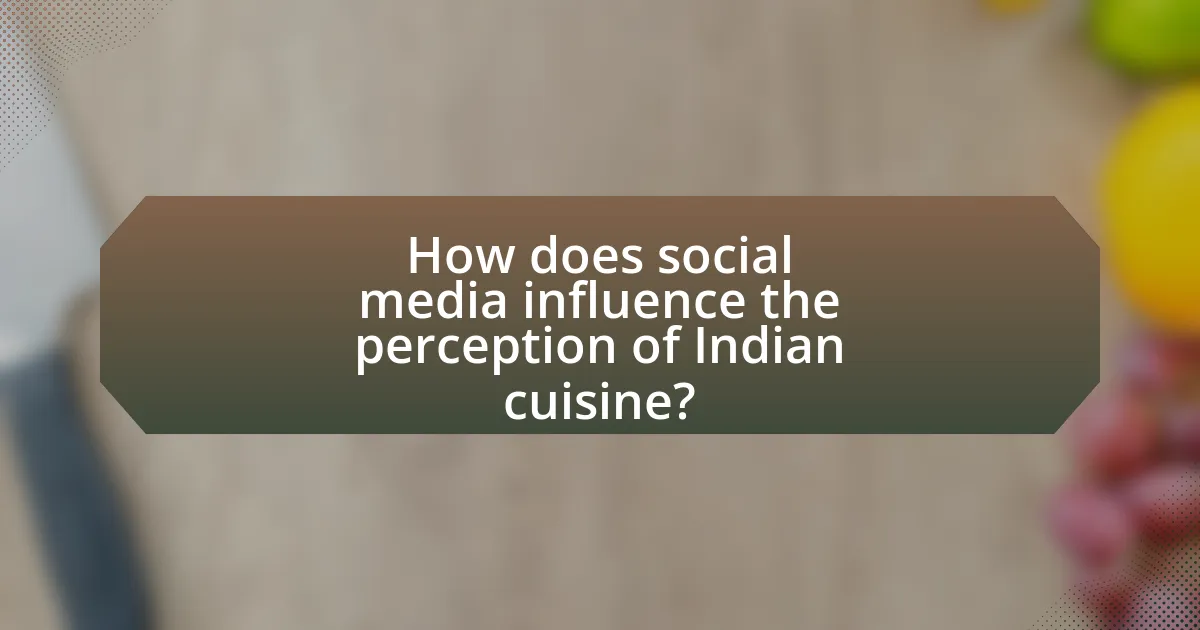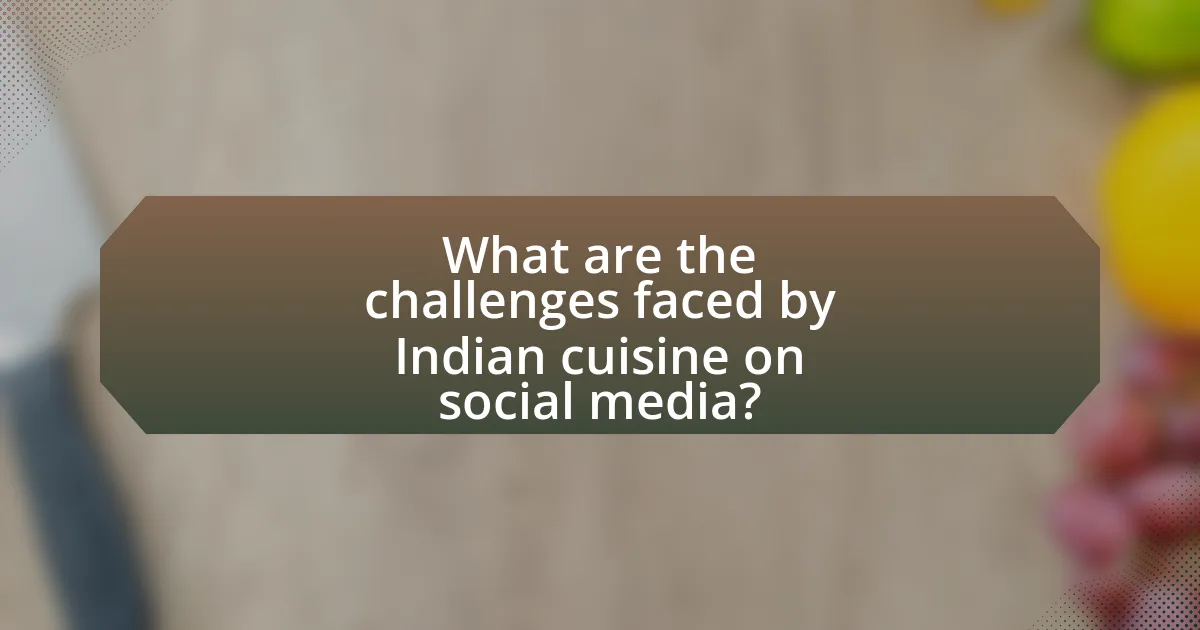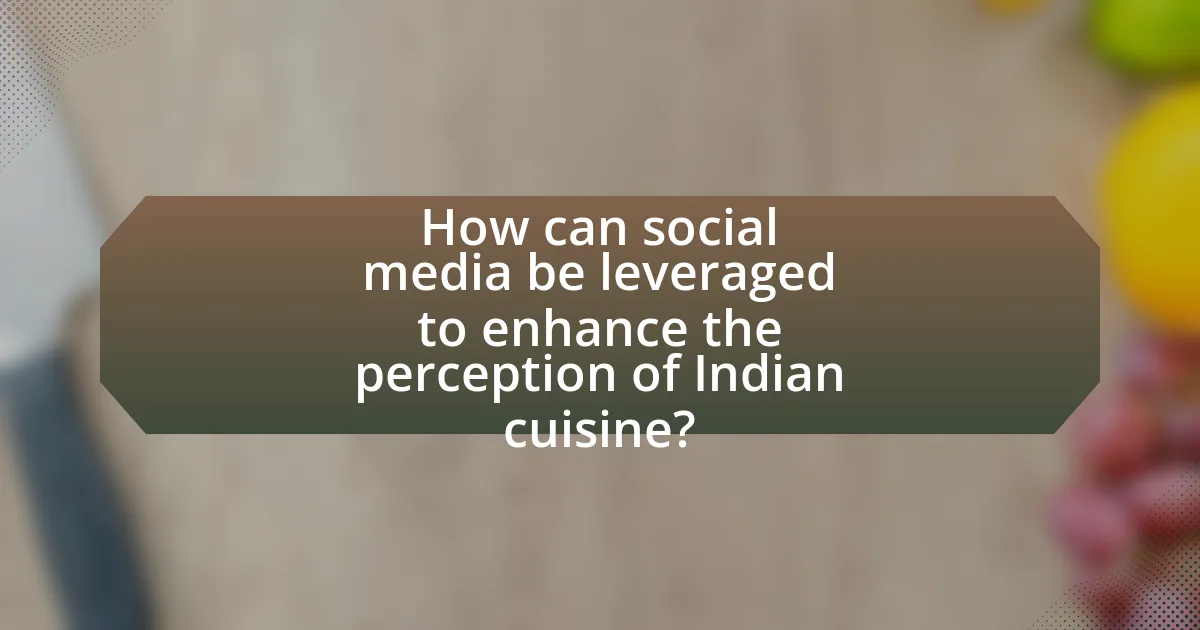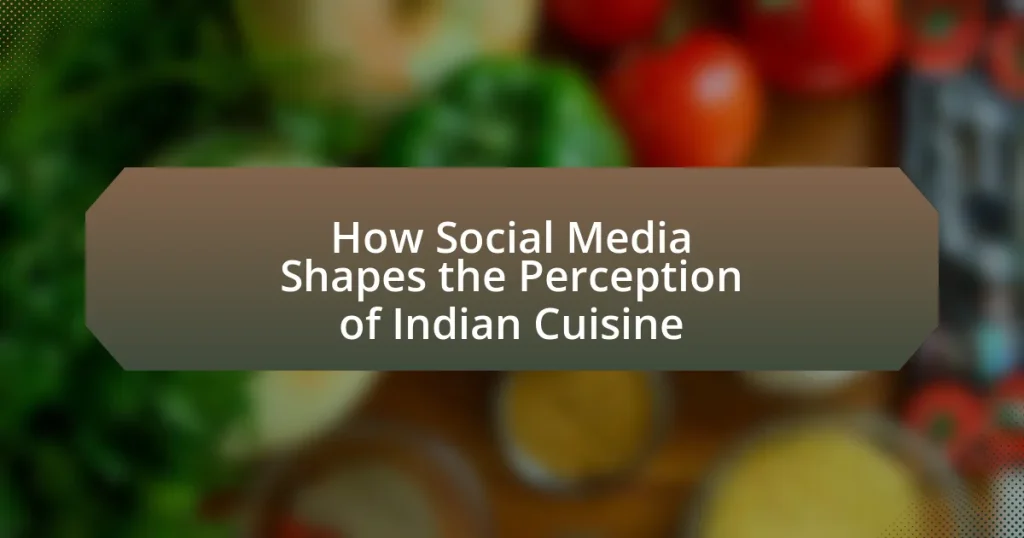The article examines how social media influences the perception of Indian cuisine, highlighting its role in showcasing the diversity and cultural richness of the food through visually appealing content. It discusses the impact of food influencers, the effectiveness of visual content in promoting Indian dishes, and the psychological effects of food photography on consumer choices. Additionally, the article addresses challenges such as misrepresentation and cultural appropriation, while emphasizing the importance of authentic representations and community engagement in reshaping perceptions of Indian cuisine. Key strategies for restaurants and businesses to market Indian food online are also outlined, focusing on storytelling, influencer collaborations, and effective social media practices.

How does social media influence the perception of Indian cuisine?
Social media significantly influences the perception of Indian cuisine by showcasing its diversity and cultural richness through visually appealing content. Platforms like Instagram and TikTok allow users to share vibrant images and videos of Indian dishes, which enhances their attractiveness and encourages exploration among a global audience. Research indicates that visual content can increase engagement and interest in food, with studies showing that posts featuring colorful and well-presented meals receive higher interaction rates. This visual representation helps to demystify Indian cuisine, making it more accessible and appealing to those unfamiliar with it, thereby shaping a positive perception and increasing its popularity worldwide.
What role does social media play in shaping culinary trends?
Social media significantly influences culinary trends by facilitating the rapid dissemination of food-related content and fostering community engagement around culinary experiences. Platforms like Instagram and TikTok allow users to share visually appealing food images and videos, which can quickly go viral, leading to the popularity of specific dishes or cooking styles. For instance, the rise of food influencers has been documented to create trends such as the popularity of plant-based diets and fusion cuisines, as seen in the increased interest in Indian street food adaptations. According to a study published in the Journal of Culinary Science & Technology, 70% of consumers reported that social media influenced their food choices, highlighting its role in shaping culinary preferences and trends.
How do food influencers impact the perception of Indian dishes?
Food influencers significantly shape the perception of Indian dishes by showcasing them through visually appealing content and personal narratives. Their curated posts often highlight the diversity and richness of Indian cuisine, making it more accessible and appealing to a global audience. For instance, influencers frequently share recipes, cooking tips, and cultural stories associated with Indian dishes, which can enhance appreciation and understanding among their followers. This impact is evidenced by the rise in popularity of Indian food hashtags on platforms like Instagram, where posts featuring Indian cuisine have garnered millions of likes, indicating increased interest and engagement.
What types of content are most effective in promoting Indian cuisine on social media?
Visual content, particularly high-quality images and videos of Indian dishes, is most effective in promoting Indian cuisine on social media. Research indicates that posts featuring vibrant, appetizing visuals generate higher engagement rates, with studies showing that images can increase likes by up to 94%. Additionally, recipe videos and cooking tutorials that showcase the preparation of traditional Indian dishes attract significant viewer interest, as they provide both entertainment and educational value. User-generated content, such as food reviews and personal experiences shared by customers, also enhances authenticity and encourages community interaction, further promoting Indian cuisine on platforms like Instagram and Facebook.
Why is visual appeal important in the representation of Indian cuisine?
Visual appeal is crucial in the representation of Indian cuisine because it significantly influences consumer perception and engagement. The vibrant colors, intricate presentations, and diverse textures of Indian dishes attract attention, making them more shareable on social media platforms. Research indicates that visually appealing food images can increase the likelihood of sharing and liking posts, thereby enhancing the visibility of Indian cuisine. For instance, a study published in the journal “Appetite” found that food presentation affects taste perception and enjoyment, highlighting the importance of aesthetics in culinary experiences. This visual engagement not only promotes Indian cuisine but also fosters cultural appreciation and curiosity among a global audience.
How do images and videos affect audience engagement with Indian food?
Images and videos significantly enhance audience engagement with Indian food by providing visually appealing content that stimulates interest and appetite. Research indicates that visual content can increase engagement rates by up to 94%, as it captures attention more effectively than text alone. For instance, platforms like Instagram and TikTok showcase vibrant dishes, which not only highlight the diversity of Indian cuisine but also encourage sharing and interaction among users. This visual representation fosters a deeper emotional connection, leading to increased curiosity and desire to explore Indian food further.
What are the psychological effects of food photography on consumer choices?
Food photography significantly influences consumer choices by enhancing the visual appeal of dishes, which can trigger emotional responses and cravings. Research indicates that visually appealing images can increase the likelihood of purchasing a food item, as they create a perception of higher quality and desirability. A study published in the Journal of Consumer Research found that food images can activate brain regions associated with reward, leading to increased motivation to consume the depicted items. Additionally, the presence of vibrant colors and artistic presentation in food photography can evoke positive emotions, further driving consumer interest and decision-making.
How does social media create a sense of community around Indian cuisine?
Social media creates a sense of community around Indian cuisine by facilitating the sharing of recipes, cooking tips, and cultural stories among users. Platforms like Instagram and Facebook allow individuals to showcase their culinary creations, fostering engagement through likes, comments, and shares. This interaction not only builds connections among food enthusiasts but also promotes a collective identity centered on Indian culinary traditions. For instance, hashtags such as #IndianFood and #HomeCookedIndia enable users to discover and connect with others who share similar interests, reinforcing a sense of belonging. Additionally, social media groups dedicated to Indian cooking provide spaces for members to exchange ideas and support each other, further solidifying community ties.
What platforms are most popular for sharing Indian food experiences?
Instagram and Facebook are the most popular platforms for sharing Indian food experiences. Instagram’s visual-centric approach allows users to showcase vibrant food photography, while Facebook facilitates community engagement through groups and event sharing. According to a 2021 survey by Statista, 67% of users reported using Instagram for food-related content, highlighting its significance in food culture. Additionally, Facebook’s extensive user base enables diverse discussions and sharing of recipes, further enhancing the visibility of Indian cuisine.
How do user-generated content and reviews shape perceptions of Indian restaurants?
User-generated content and reviews significantly shape perceptions of Indian restaurants by influencing potential customers’ decisions through shared experiences and opinions. Positive reviews can enhance a restaurant’s reputation, leading to increased foot traffic and customer loyalty, while negative reviews can deter potential diners. Research indicates that 79% of consumers trust online reviews as much as personal recommendations, highlighting the impact of user-generated content on consumer behavior. Additionally, platforms like Yelp and TripAdvisor provide a space for diners to share their experiences, which can create a collective narrative about a restaurant’s quality, authenticity, and service. This collective feedback directly affects how Indian restaurants are perceived in a competitive market.

What are the challenges faced by Indian cuisine on social media?
Indian cuisine faces several challenges on social media, including misrepresentation, cultural appropriation, and the oversimplification of diverse dishes. Misrepresentation occurs when traditional recipes are altered or presented inaccurately, leading to a skewed perception of the cuisine. Cultural appropriation is another significant issue, where non-Indian creators adopt Indian culinary elements without proper acknowledgment, often diluting the cultural significance. Additionally, the oversimplification of Indian dishes into easily digestible formats can undermine the complexity and richness of the cuisine, resulting in a lack of appreciation for its authentic flavors and techniques. These challenges hinder the accurate portrayal and understanding of Indian cuisine in the digital landscape.
How do stereotypes and misconceptions affect the portrayal of Indian food?
Stereotypes and misconceptions significantly distort the portrayal of Indian food by oversimplifying its diversity and richness. For instance, many people associate Indian cuisine solely with curry and spicy dishes, neglecting the vast array of regional variations, ingredients, and cooking techniques that exist across India. This narrow view can lead to a lack of appreciation for dishes like dosa, biryani, or regional specialties that vary greatly in flavor and preparation. Additionally, misconceptions about Indian food being universally spicy can alienate potential consumers who may be sensitive to heat, thus limiting their culinary exploration. Research indicates that social media amplifies these stereotypes, as platforms often showcase a limited representation of Indian cuisine, reinforcing existing biases and hindering a more nuanced understanding of its culinary landscape.
What common myths about Indian cuisine are perpetuated on social media?
Common myths about Indian cuisine perpetuated on social media include the belief that all Indian food is extremely spicy, that it primarily consists of curry, and that it is unhealthy due to the use of ghee and fried foods. The misconception that all Indian dishes are spicy overlooks the diversity of flavors and regional variations, as many dishes are mild and focus on different spices. Additionally, the notion that Indian cuisine is predominantly curry ignores the vast array of dishes such as biryanis, dosas, and tandoori items. Lastly, while ghee is used in some recipes, Indian cuisine also includes numerous healthy options like lentils, vegetables, and whole grains, which are often overlooked in social media portrayals.
How can these misconceptions be addressed through social media campaigns?
Misconceptions about Indian cuisine can be effectively addressed through targeted social media campaigns that promote accurate representations and diverse culinary experiences. By utilizing visually appealing content, such as high-quality images and videos of authentic dishes, campaigns can showcase the variety and richness of Indian cuisine, countering stereotypes that it is solely about curry or overly spicy food. Engaging storytelling that highlights regional specialties and cultural significance can further educate audiences, as evidenced by successful campaigns like #IndianFoodChallenge, which encouraged users to share their own experiences with different Indian dishes, fostering a sense of community and understanding. Additionally, collaborations with food influencers and chefs can lend credibility and reach wider audiences, as seen in campaigns that have increased awareness and appreciation for lesser-known Indian dishes, thereby reshaping perceptions effectively.
What are the implications of cultural appropriation in the context of Indian cuisine?
Cultural appropriation in the context of Indian cuisine often leads to the commodification and misrepresentation of traditional dishes, which can undermine the cultural significance and authenticity of these foods. When individuals or businesses adopt Indian culinary elements without understanding their cultural roots, it can result in a dilution of the cuisine’s heritage and a lack of respect for its origins. For instance, the popularization of “Indian-inspired” dishes in Western restaurants frequently strips away the traditional methods and ingredients that define authentic Indian cooking, leading to a skewed perception of the cuisine. This appropriation can also perpetuate stereotypes and reinforce power imbalances, as those who profit from these adaptations may not acknowledge or compensate the original cultures.
How does cultural appropriation manifest in social media representations of Indian food?
Cultural appropriation in social media representations of Indian food manifests through the commercialization and simplification of traditional dishes, often stripping them of their cultural significance. Influencers and brands frequently present Indian cuisine in a manner that emphasizes aesthetics over authenticity, leading to misrepresentations that can perpetuate stereotypes. For example, the popularization of “curry” as a catch-all term for various Indian dishes overlooks the regional diversity and historical context of Indian culinary practices. This trend is evident in platforms like Instagram, where visually appealing but culturally inaccurate portrayals can garner significant attention, overshadowing the rich heritage and traditions associated with Indian food.
What can be done to promote authentic representations of Indian cuisine?
To promote authentic representations of Indian cuisine, social media platforms should prioritize showcasing traditional recipes and cooking methods through verified chefs and home cooks. This approach can be supported by initiatives such as featuring regional diversity in Indian cuisine, highlighting local ingredients, and sharing cultural stories behind dishes. Research indicates that visual content significantly influences food perceptions; therefore, high-quality images and videos that accurately depict the preparation and presentation of authentic dishes can enhance understanding and appreciation. Additionally, collaborations with food historians and cultural experts can provide context and credibility, ensuring that representations are both accurate and respectful of the culinary heritage.

How can social media be leveraged to enhance the perception of Indian cuisine?
Social media can be leveraged to enhance the perception of Indian cuisine by showcasing its diversity and cultural significance through visually appealing content. Platforms like Instagram and TikTok allow chefs and food enthusiasts to share vibrant images and videos of traditional dishes, which can attract a global audience. For instance, the hashtag #IndianFood has garnered millions of posts, highlighting the popularity and reach of Indian cuisine online. Additionally, engaging storytelling about the origins and ingredients of dishes can create a deeper appreciation among viewers, as seen in campaigns by Indian restaurants that emphasize local sourcing and authentic recipes. This strategic use of social media not only promotes Indian cuisine but also fosters a sense of community and cultural exchange, ultimately enhancing its perception worldwide.
What strategies can restaurants use to effectively market Indian cuisine online?
Restaurants can effectively market Indian cuisine online by utilizing social media platforms to showcase visually appealing dishes, engage with customers through interactive content, and leverage targeted advertising. High-quality images and videos of Indian dishes can attract attention and stimulate interest, as studies show that visual content increases engagement rates by up to 94%. Additionally, restaurants can create polls, quizzes, and live cooking demonstrations to foster interaction, which enhances customer loyalty and brand recognition. Targeted ads on platforms like Facebook and Instagram can reach specific demographics interested in Indian cuisine, increasing the likelihood of attracting new customers.
How can storytelling enhance the appeal of Indian dishes on social media?
Storytelling can enhance the appeal of Indian dishes on social media by creating emotional connections and cultural context that resonate with audiences. When narratives highlight the origins, traditions, and personal experiences associated with specific dishes, they engage viewers more deeply than mere visuals or descriptions. For instance, sharing the history of a family recipe or the significance of a dish during festivals can evoke nostalgia and curiosity, prompting users to explore and share the content. Research indicates that posts with storytelling elements receive 300% more engagement than those without, demonstrating the effectiveness of this approach in capturing attention and fostering community around Indian cuisine.
What role do collaborations with influencers play in promoting Indian cuisine?
Collaborations with influencers play a significant role in promoting Indian cuisine by leveraging their reach and credibility to engage a wider audience. Influencers often create visually appealing content that showcases Indian dishes, making them more accessible and appealing to their followers. For instance, a study by the Pew Research Center found that 72% of teenagers in the U.S. use Instagram, where food influencers frequently share recipes and cooking tips, thereby increasing interest in diverse cuisines, including Indian. This exposure not only enhances the visibility of Indian cuisine but also fosters a positive perception, encouraging followers to explore and try these dishes.
What best practices should be followed for promoting Indian cuisine on social media?
To effectively promote Indian cuisine on social media, it is essential to utilize high-quality visuals, engaging storytelling, and interactive content. High-quality images and videos of dishes attract attention and showcase the vibrant colors and textures of Indian food, which can increase engagement rates. Engaging storytelling about the cultural significance and history of the dishes can create a deeper connection with the audience, making them more likely to share the content. Additionally, interactive content such as polls, quizzes, and live cooking demonstrations can enhance user participation and foster a community around Indian cuisine. According to a study by the National Restaurant Association, 70% of consumers are influenced by social media when deciding where to eat, highlighting the importance of a strong social media presence for promoting culinary traditions.
How can businesses measure the success of their social media campaigns related to Indian food?
Businesses can measure the success of their social media campaigns related to Indian food by analyzing key performance indicators (KPIs) such as engagement rates, reach, conversion rates, and customer feedback. Engagement rates, which include likes, shares, and comments, indicate how well the content resonates with the audience. Reach measures the number of unique users who see the content, providing insight into brand visibility. Conversion rates track the percentage of users who take desired actions, such as making a purchase or signing up for a newsletter, directly linked to the campaign. Customer feedback, gathered through comments and reviews, offers qualitative insights into audience perceptions and satisfaction. According to a 2021 report by Hootsuite, brands that actively engage with their audience on social media see a 20-40% increase in customer loyalty, reinforcing the importance of these metrics in evaluating campaign success.
What are the key elements of a successful social media strategy for Indian cuisine?
The key elements of a successful social media strategy for Indian cuisine include engaging content, targeted audience outreach, and consistent branding. Engaging content, such as visually appealing food photography and videos showcasing cooking techniques, captures attention and encourages sharing. Targeted audience outreach involves identifying demographics interested in Indian cuisine, such as food enthusiasts and cultural explorers, to tailor messaging effectively. Consistent branding ensures that the visual and thematic elements of posts align with the essence of Indian cuisine, fostering recognition and loyalty. According to a study by the Pew Research Center, 69% of adults in India use social media, highlighting the importance of these platforms for reaching a broad audience.
